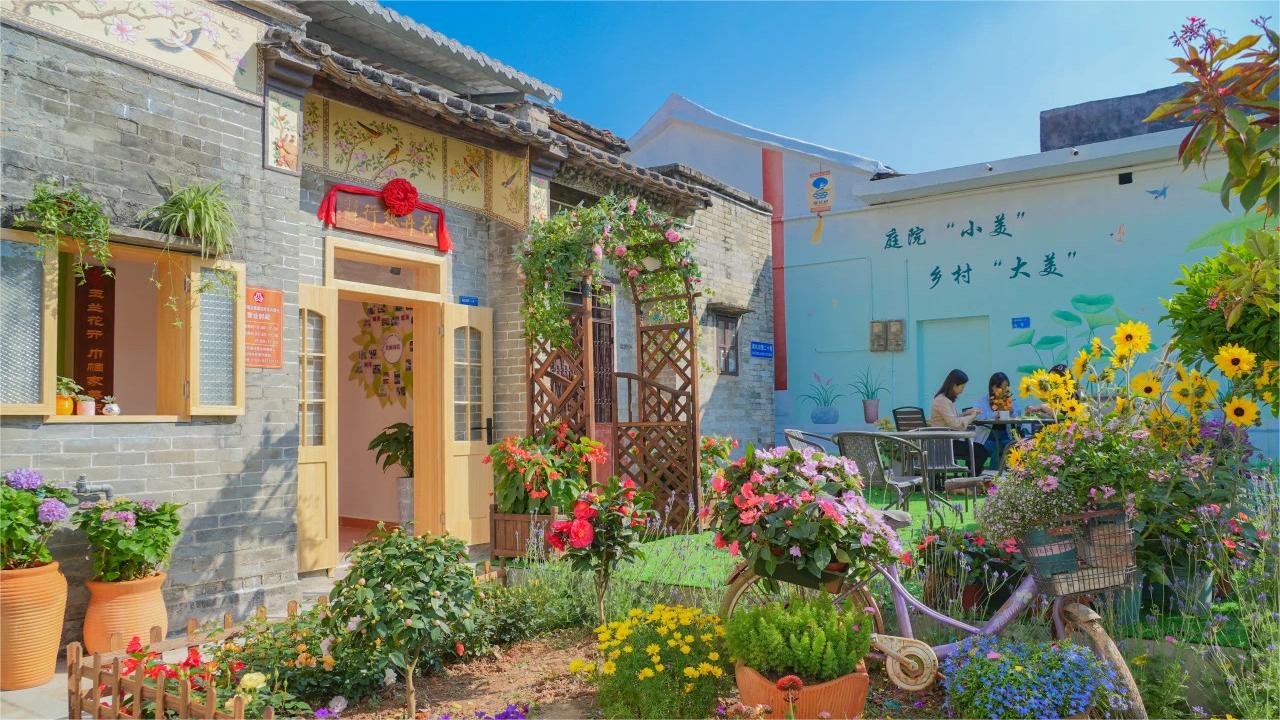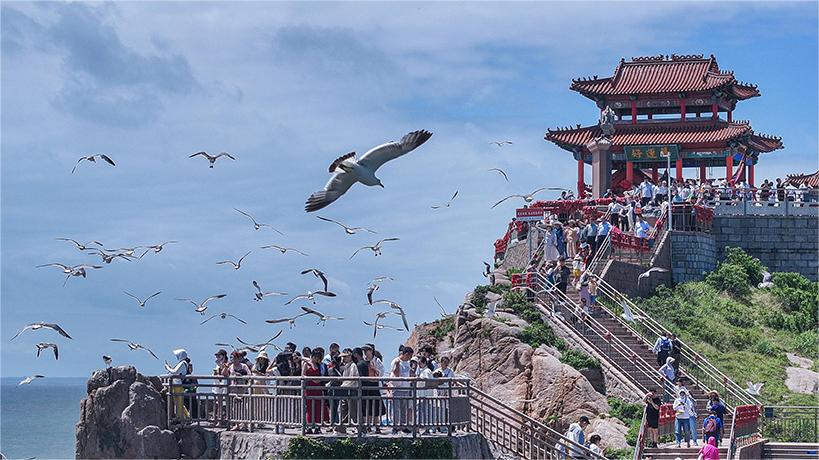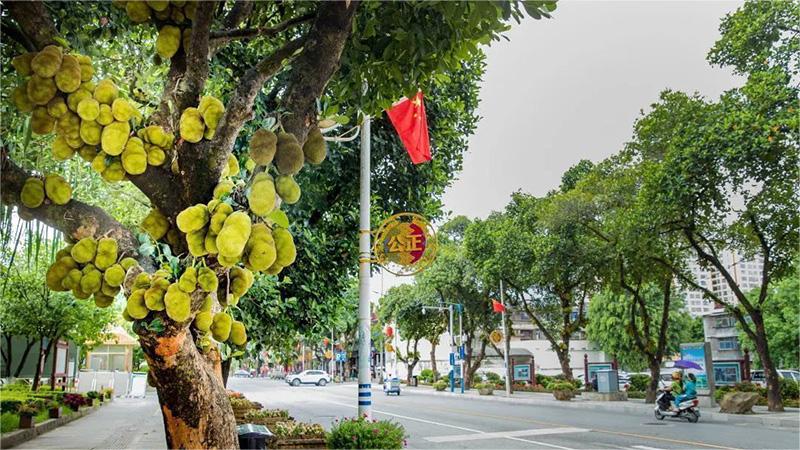China's rising stars serve notice on tennis world
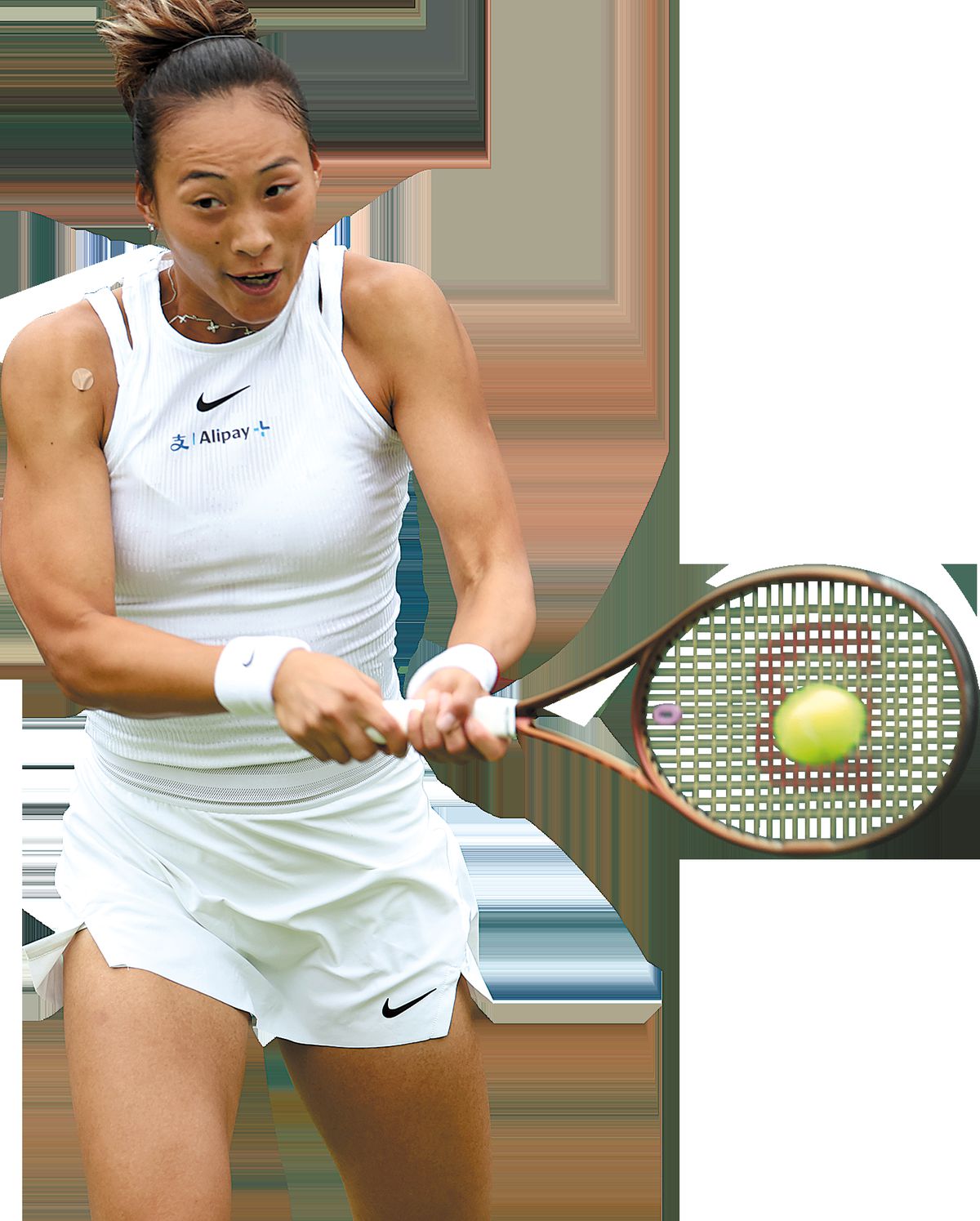
Zheng Qinwen in action during her first round match against New Zealand's Lulu Sun at the Wimbledon Championships, southwest London, on July 1. LI YING/XINHUA
Twenty years since its golden breakthrough at the Athens 2004 Olympic Games, Chinese tennis has come a long way toward reaching the sport's top echelons, with this year's Wimbledon Championships bearing witness to the rapid progress.
Highlighted by its biggest representation at a Grand Slam and a young star making it into the second week, Chinese tennis is celebrating a remarkable campaign at this year's Wimbledon, where the country's next-gen talents served notice they are a rising force.
Li Ting and Sun Tiantian, now both retired, lit the spark by winning an unexpected gold in the women's doubles at the Athens Olympics.
The nation's most famous tennis player Li Na then ignited interest in the sport in China by winning Asia's first individual Grand Slam title at the 2011 French Open, followed by another at the 2014 Australian Open.
Her heroics inspired a tennis boom that has grown exponentially over the past decade, with more players entering the sport's elite ranks, more courts and facilities being built, and a larger number of international tournaments being played in China.
At this year's Wimbledon, 11 Chinese players featured in the men's and women's main draws at the All-England Club — the most the country has had to compete at any of the four tennis majors.
Professional approach
Talent development is at the core of the revolution, and it has evolved profoundly in China. But players have also embraced professionalism, managing their careers on their own supported by a crew of coaches, fitness trainers, physios, and agents, who are outside the traditional State-run sports system.
The result of this new professional approach has been quite encouraging, especially on the women's side.
Spearheaded by world No 7 Zheng Qinwen, China this week has six players ranked in the top 100 on the Women's Tennis Association Tour. Only the United States, Russia, and the Czech Republic have more players than China in the women's top 100 with 13,12, and eight respectively.
Their predecessors' legacy has paid dividends for China's current generation, who have benefited from early exposure to professional tennis and more access to international events.
"I think players now know better, and earlier, about what it is like to live, breathe, and play as a pro than what we did in the beginning," said retired star Zheng Jie, who won the 2006 Wimbledon women's doubles with Yan Zi.
"When we started we had no clue at all about being a professional tennis player, a very limited number of high-level tournaments to play at home, and did not know how to develop our game in the right way.
"I am really proud of how far the game has come in China. Sometimes I envy the current generation very much for the advantages they have now," said Zheng Jie, who was invited back to London to play in a legends' exhibition doubles tournament last week.
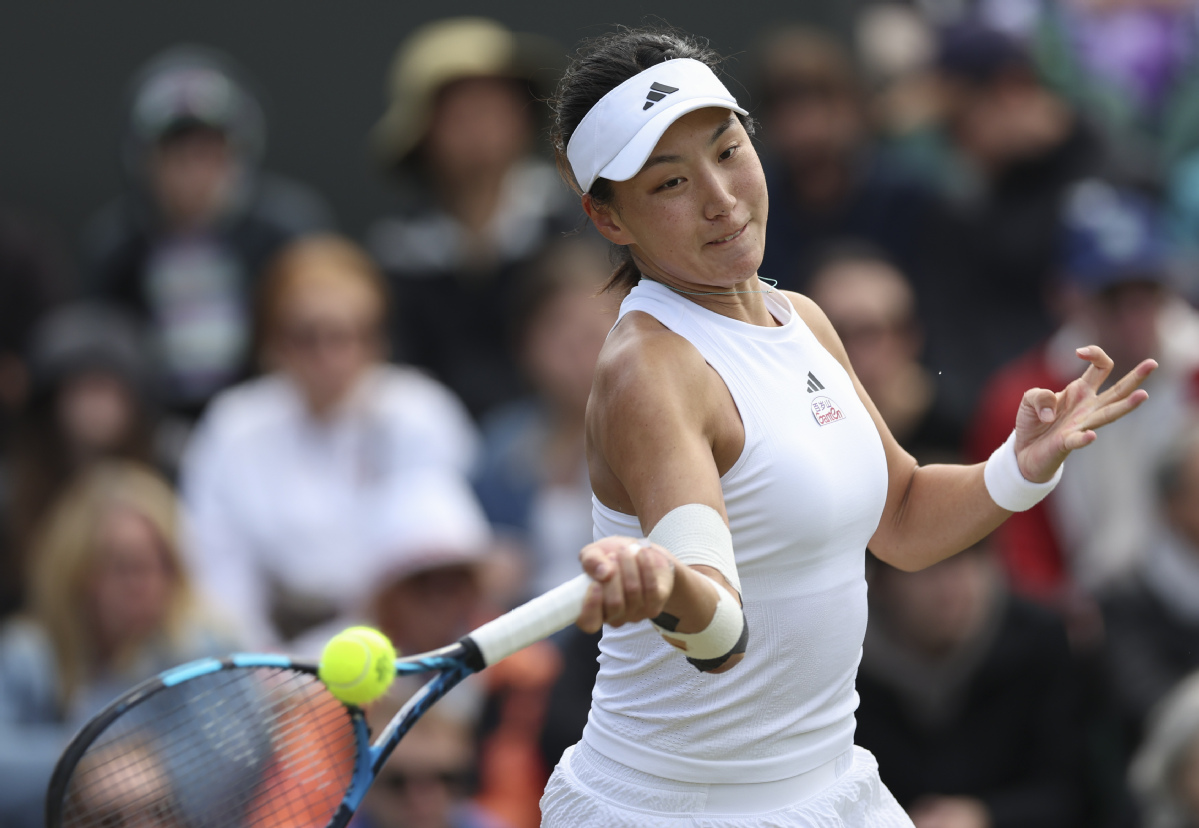
Wang Xinyu hits a forehand at Wimbledon on July 6. (HAN YAN/XINHUA)
New breed
China's world No 36 Wang Xinyu was one of the highlights of the women's draw last week after she fought her way into the fourth round, her best performance at a major and the furthest an individual Chinese player advanced at this year's Wimbledon.
The 22-year-old, a winner of the 2018 Wimbledon girls' doubles, said her deep run in London was a great learning curve.
"My whole experience of fighting into the second week for the first time here was priceless," Wang said after losing to Ukraine's world No 21 Elina Svitolina 6-2,6-1 in the round of 16 on July 8.
"Although the result didn't happen as expected today, I still finished this year's tournament with a lot of positive takeaways, knowing better where I should push for further improvement," Wang said.
"The chances of competing against the more established international opponents and measuring my game against them were a great lesson."
Born into a sporting family, Wang's development has mirrored many of the game's international stars. She started practicing tennis at the age of 6 influenced by her father, a former national team coach. She trained overseas and honed her skills on the International Tennis Federation's junior circuit before breaking onto the world stage as a teenager.
After winning a wild-card playoff in December 2017, Wang earned direct entry into the 2018 Australian Open. At the age of 16, she became the youngest Chinese mainland player to ever play in the main draw at Melbourne Park. To add to the luster, she won the girls' doubles title with partner Liang En-shuo of Chinese Taipei the same year.
The 1.83-meter power hitter, who has inherited her father's touch and the height of her mother, a former basketball player, has since emerged as a rising star on the WTA Tour.
Her support team includes Croatian coach Miro Hrvatin, a full-time fitness trainer, a physio, and an agent from IMG, the Florida-based sports marketing giant that has signed most of China's top players.

Bai Zhuoxuan hits a return during the 2024 Wimbledon Championships on July 2. (LI YING/XINHUA)
Modern methods
Modern talent development methods are also behind the success of China's top woman Zheng Qinwen, a finalist at this year's Australian Open, and winner of the WTA's Most Improved Player of the Year award in 2023.
Encouraged by her parents, Zheng picked up a tennis racket for the first time at the age of 6 in her home province of Hubei, where Li Na also hails from.
She later moved to Beijing to develop her talent at an academy run by Argentine mentor Carlos Rodriguez, who coached Li to her second major victory in Melbourne in 2014.
Now based in Barcelona and training with Spanish coach Pere Riba, a former ATP world No. 65, Zheng has set her sights on diversifying her arsenal beyond her blistering forehand and serve in order to mix it with the world's best.
Since her breakout season in 2022, Zheng has completed one of the fastest ascents of the women's tour rankings. In January, she reached a career-high of seven, following her Australian Open heroics, climbing all the way from 125th at the end of 2021.
Despite elimination in the first round at Wimbledon, the 21-year-old aggressive baseliner, represents the future of Chinese women's tennis together with her peers Wang Xinyu and Bai Zhuoxuan, all top-150 players born after 2000.
Their collective strength, and the diversity of their game styles and personalities, have sparked comparisons to the "Golden Flowers" generation of the early 2010s, when Li Na, Zheng Jie, and Yan Zi made the nation proud on the pro circuit.
"Obviously, 15 years ago in China, tennis was just beginning," said Zheng Qinwen, winner of two WTA singles titles. "So we didn't have much opportunity to improve our system of coaching," she said.
"Now after 15 years, we know more about the world, we know how everybody is playing, and we try a lot of different coaches to really improve our games. So all of us are starting to have more knowledge about tennis."
Home court advantage
Organizers and promoters have also played their part in bringing more high-level tournaments to China to keep pace with the on-court breakthroughs.
From hosting only three professional tournaments before 2010, China has seven WTA tournaments and five men's Association of Tennis Professionals events scheduled this year and has become one of the busiest destinations on the professional tennis calendar.
The China Open, already the biggest men's and women's combined tournament in Asia, is getting bigger and better this year, thanks to the growing domestic appetite for elite tennis.
In April, the tournament organizers announced the women's tournament will be upgraded to a two-week format with 96 draws, up from 64 last year, joining Indian Wells, Miami, Madrid, and Rome as the fifth top-flight WTA1000 tournament.
On the men's side, the ATP500 tournament is expected to continue serving up high-quality players. Grand Slam champions Carlos Alcaraz of Spain, Daniil Medvedev of Russia, and Italy's Jannik Sinner have all confirmed that they will return to Beijing this fall after having featured in last year's star-studded men's draw.
The total prize money for the tournament, which runs from Sept 23 to Oct 6 at Beijing's National Tennis Center, will be increased to a record $13.14 million this year.
As the country pushes the sports sector as a new economic pillar, the growth of businesses around events such as the China Open, has coincided with the central government's call to increase sports industry revenue to 5 trillion yuan ($688 billion) by the end of next year.
During the National Day holiday, visitors to the National Tennis Center in Beijing, where the tournament has been held since 2009, flocked to numerous merchandise outlets, tennis academy booths, equipment stores, and restaurants, signaling growing public demand for sports-related activities and products.
The 2023 China Open, the first event held after a three-year pandemic hiatus, saw multiple records broken. Total attendance for the event hit 250,000, with an on-site consumption of 18 million yuan ($2.48 million). The total viewership in Europe also increased by 33.9 percent.
Now, with China's own top players holding court, the sport's popularity, facilitated by an array of home tournaments, will only grow bigger, said China Open's co-director Lars Graff.
"It will be a huge advantage for spectators to have a chance to see the Chinese players in action," said Graff, a former vice-president of the ATP tour, who's been closely following the sport's growth in China.
"They're doing very well internationally, and now they're coming home to play. I think that tennis is booming right now in China."
Photos
Related Stories
- China's eighth seed Zheng ousted from Wimbledon first round
- Wimbledon tennis Championship: Elina Svitolina vs. Wang Xinyu
- In pics: women's doubles 1st round match at Wimbledon
- Wimbledon: Swiatek ousted from third round, China's Wang reaches last 16
- In pics: women's doubles at Wimbledon tennis Championship
- China's Wang Xinyu stunned 5th seed Pegula at Wimbledon
Copyright © 2024 People's Daily Online. All Rights Reserved.






